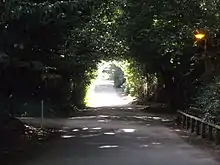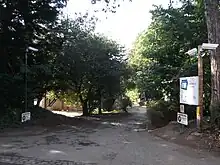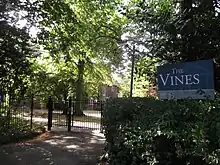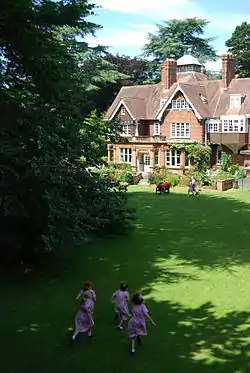Pullens Lane
Pullens Lane (a.k.a. Pullen's Lane[1]) is in Headington, east Oxford, England. It is located at the top of Headington Hill, leading north off Headington Road to Jack Straw's Lane and Harberton Mead. The cul-de-sac Pullens Field (a.k.a. Pullen's Field, named in 1972[2]) leads off west from Pullens Lane.

History
The lane was named after the Rev. Josiah Pullen (1631–1714), vicar of St Peter-in-the-East in central Oxford (where he is buried) and Vice-President of Magdalen Hall.[3] He used to walk in this area to the top of Headington Hill and admire the view of Oxford. He planted an elm tree in the locality in about 1680. The tree became known as Joe Pullen's tree, but was destroyed by a fire on 13 October 1909. There is a tablet in the wall of Davenport House here recording the event on the east side of the lane. The road was named Pullen's Lane in 1930.[1]
Buildings
Pullens Lane includes a number of notable buildings,[4] especially by the Victorian architect Harry Wilkinson Moore (1850–1915).[5] Buildings by Wilkinson include:
- The Vines, occupied by Scholarship & Christianity in Oxford (SCIO), previously The Vineyard and Pollock House, built in 1889–90.[6]
- Cotuit Hall, part of the EF International Academy's Oxford campus, until 2011 one of the halls of residence at Oxford Brookes University, and previously known as Napier House, built in 1892.[7]
Other buildings include:
- Pullen's Gate (previously known as Brockless Cottage and Brockleaze), formerly owned by Francis John Lys (1863–1947), Provost of Worcester College, Oxford and Vice-Chancellor of Oxford University.[8]
- Headington Hill Hall, designed by John Thomas, built in 1824 (extended 1856–8), and owned by the Morrell's brewery family, now leased by Oxford Brookes University.
Educational institutions
Rye St Antony School, founded in 1930, is located in Pullens Lane. It started in central Oxford and moved to a 12-acre (49,000 m2) site on the east side of Pullens Lane in 1939.[9]
Plater College moved from makeshift facilities at Boars Hill south of Oxford to a new purpose-built residential college on Pullens Lane, after demolishing Fairfield (previously known as The Pullens) during the 1970s,[10] under the leadership of Joseph Kirwan (1910–2005).[11] The college closed in 2005. The site is now occupied by the EF International Academy (formerly the EF International Language School).[10]
Gallery
 The EF International Language Centres Oxford Campus main entrance on Pullens Lane.
The EF International Language Centres Oxford Campus main entrance on Pullens Lane. Entrance to Cotuit Hall, part of EF Academy, also on Pullens Lane.
Entrance to Cotuit Hall, part of EF Academy, also on Pullens Lane. View through the main gate of The Vines on Pullens Lane.
View through the main gate of The Vines on Pullens Lane. King House at Rye St Antony School, off Pullens Lane.
King House at Rye St Antony School, off Pullens Lane.
References
- Symonds, Ann Spokes; Morgan, Nigel (2010). "Pullen's Lane". The Origins of Oxford Street Names. Robert Boyd Publications. p. 175. ISBN 978-1-899536-99-3.
- Symonds, Ann Spokes; Morgan, Nigel (2010). "Pullen's Field". The Origins of Oxford Street Names. Robert Boyd Publications. p. 174. ISBN 978-1-899536-99-3.
- Hibbert, Christopher, ed. (1988). "Pullen's Lane". The Encyclopaedia of Oxford. Macmillan. pp. 341–342. ISBN 0-333-39917-X.
- Sherwood, Jennifer; Pevsner, Nikolaus (1974). Oxfordshire. The Buildings of England. Harmondsworth: Penguin Books. p. 338. ISBN 0-14-071045-0.
- Andrew Saint, Three Oxford Architects Archived 28 September 2007 at the Wayback Machine, Oxfordshire Architectural and Historical Society, UK.
- The Vineyard (Pollock House), Pullens Lane Archived 10 September 2012 at the Wayback Machine, Headington, Oxford, UK.
- Napier House (later Cotuit Hall), Pullens Lane Archived 28 March 2014 at the Wayback Machine, Headington, Oxford, UK.
- Pullen’s Gate/Brockless Cottage, Pullens Lane Archived 7 October 2008 at the Wayback Machine, Headington, Oxford, UK.
- About the School, Rye St Antony School, Oxford, UK.
- The Pullens (later Fairfield), Pullens Lane Archived 6 September 2012 at the Wayback Machine, Headington, Oxford, UK.
- Joseph Kirwin Obituary Archived 2 July 2011 at the Wayback Machine, Oxford Mail, 31 March 2005.